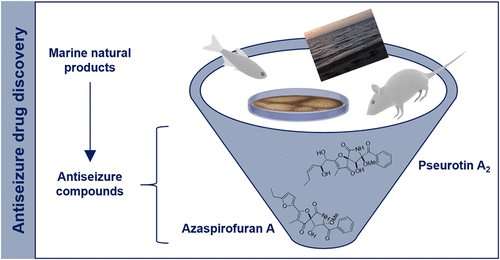Red Sea fungus yields leads for new epilepsy drugs

New treatments for epilepsy are sorely needed because current medications don't work for many people with the disease. To find new leads, researchers have now turned to the sea—a source of unique natural products that have been largely untapped for prospective drugs. The scientists report in the journal ACS Chemical Neuroscience that two metabolites produced by a fungus from the Red Sea look promising.
The term "epilepsy" covers a spectrum of brain disorders with symptoms ranging from mildly odd sensations to seizures, loss of consciousness and death. Worldwide, the condition affects 50 million people, according to the World Health Organization. Current treatments work in only about 70 percent of those who try them. To identify some new options, Marcel Jaspars, Peter A. M. de Witte and colleagues teamed up in an international collaboration called the EU PharmSea project that aimed to discover novel compounds from marine microorganisms in some of the deepest, coldest and hottest places on Earth.
According to the researchers, this study was the first-ever systematic large-scale screen of marine-derived natural products for potential anti-seizure drugs. Initial tests of a variety of these compounds revealed that two γ-lactams produced by the Red Sea fungus Aspergillus fumigatus reduced the number and length of seizures in zebrafish, a model organism they used for high-volume screening of compounds. The researchers then showed that these natural substances, known as pseurotin A2 and azaspirofuran A, also shortened seizures in a mouse model of epilepsy. The scientists recommend further investigation of these metabolites to explore their biomolecular targets and to design more potent analogs.
More information: Daniëlle Copmans et al. Zebrafish-Based Discovery of Antiseizure Compounds from the Red Sea: Pseurotin A2 and Azaspirofuran A, ACS Chemical Neuroscience (2018). DOI: 10.1021/acschemneuro.8b00060
Abstract
In search for novel antiseizure drugs (ASDs), the European FP7-funded PharmaSea project used zebrafish embryos and larvae as a drug discovery platform to screen marine natural products to identify promising antiseizure hits in vivo for further development. Within the framework of this project, seven known heterospirocyclic γ-lactams, namely, pseurotin A, pseurotin A2, pseurotin F1, 11-O-methylpseurotin A, pseurotin D, azaspirofuran A, and azaspirofuran B, were isolated from the bioactive marine fungus Aspergillus fumigatus, and their antiseizure activity was evaluated in the larval zebrafish pentylenetetrazole (PTZ) seizure model. Pseurotin A2 and azaspirofuran A were identified as antiseizure hits, while their close chemical analogues were inactive. Besides, electrophysiological analysis from the zebrafish midbrain demonstrated that pseurotin A2 and azaspirofuran A also ameliorate PTZ-induced epileptiform discharges. Next, to determine whether these findings translate to mammalians, both compounds were analyzed in the mouse 6 Hz (44 mA) psychomotor seizure model. They lowered the seizure duration dose-dependently, thereby confirming their antiseizure properties and suggesting activity against drug-resistant seizures. Finally, in a thorough ADMET assessment, pseurotin A2 and azaspirofuran A were found to be drug-like. Based on the prominent antiseizure activity in both species and the drug-likeness, we propose pseurotin A2 and azaspirofuran A as lead compounds that are worth further investigation for the treatment of epileptic seizures. This study not only provides the first evidence of antiseizure activity of pseurotins and azaspirofurans, but also demonstrates the value of the zebrafish model in (marine) natural product drug discovery in general, and for ASD discovery in particular.
Journal information: ACS Chemical Neuroscience
Provided by American Chemical Society




















